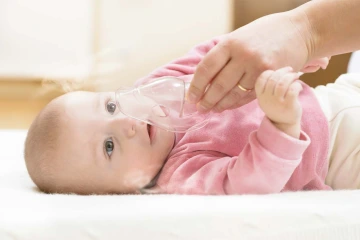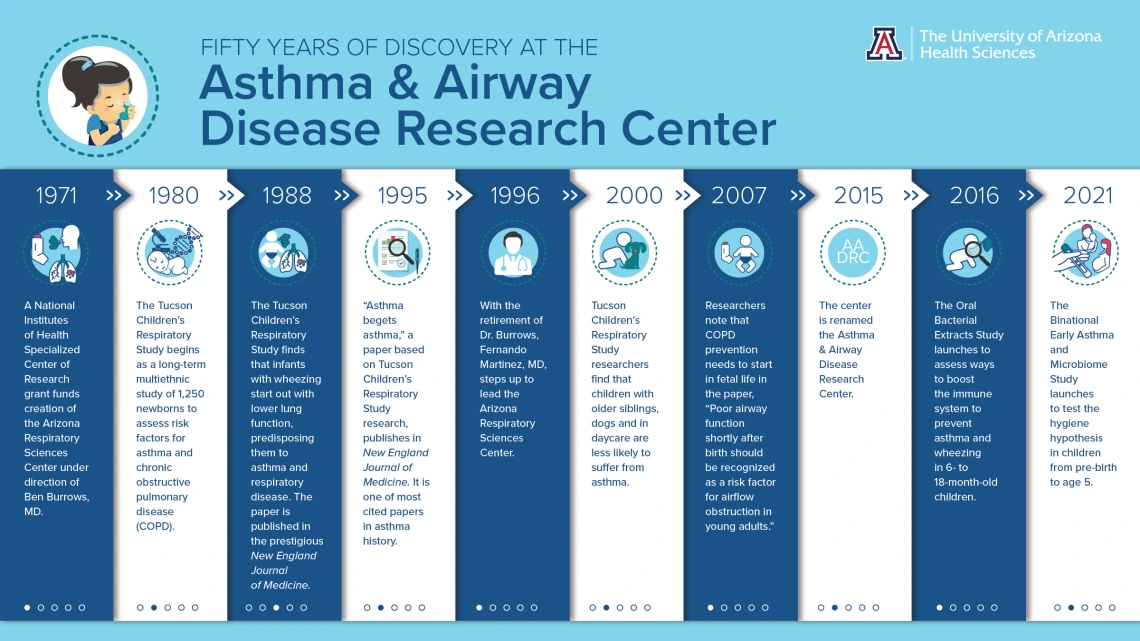Attacking Asthma: 50 Years of Life-changing Discovery
The Asthma & Airway Disease Research Center has revolutionized our scientific understanding of asthma and other respiratory diseases.

The UArizona Health Sciences Asthma & Airway Disease Research Center has spent decades researching the origins of adult respiratory diseases, including asthma and COPD, which often begin in the wheezing and lower respiratory infections of youth.
Nearly 340 million people globally and 25 million Americans – 7.7% of adults and 8.4% of children – suffer from asthma. And while there’s no cure, five decades of leading-edge research at the University of Arizona Health Sciences has helped advance scientific understanding of this respiratory illness and the therapies developed to address it.

Stefano Guerra, MD, PhD, MPH, and Fernando Martinez, MD, oversee the Tucson Children’s Respiratory Study, which is entering its fifth decade of research into childhood asthma and wheezing.
Asthma and COPD became the two main “trunks” on the center’s research tree, according to Regents Professor and Swift-McNear Professor of Pediatrics Fernando Martinez, MD, director of the center since 1996.
Both diseases figure prominently in the five most influential research papers from five decades of Asthma & Airway Disease Research Center work.
Unbending the twig
The Asthma & Airway Disease Research Center’s first decade was capped by the publication of “‘As the twig is bent, the tree inclines’ (perhaps),” in 1980. The paper, co-authored by the center’s first director, Ben Burrows, MD, and Lynn Taussig, MD, summarized the idea of “early origins” and highlighted the work that began in 1971.
Borrowing a line from 18th century poet Alexander Pope for its title, the paper stated many adult respiratory diseases, including asthma and COPD, had origins in the wheezing and lower respiratory infections of youth. This finding laid the groundwork for the Tucson Children’s Respiratory Study, which began that same year.

Wheezing in infants was the topic of the first major paper to come out of the Asthma & Airway Disease Research Center.
Dr. Martinez and Stefano Guerra, MD, PhD, MPH, the center’s epidemiology director and the Henry E. Dahlberg Chair in Asthma Research, currently lead the benchmark Tucson Children’s Respiratory Study, which began in 1980. Since then, researchers have collected health data on a multiethnic group of more than 1,000 newborns and followed them through childhood and into adulthood.
The first big paper from the study came in 1988 when “Diminished lung function as a predisposing factor for wheezing respiratory illness in infants” was published in the New England Journal of Medicine. The findings showed that lower lung function, such as narrower airways and more collapsible bronchi, predisposed infants to wheezing in their first year of life.
“That was our first discovery,” Dr. Martinez said. “That, in a certain sense, marked our way, because then most of what we did later was: What is it that happens in utero, and in early life, that may change or bend this tree in a negative direction and what needs to be done to avoid this inclining?”
Daycare, dogs and older siblings
In 1995, “Asthma and Wheezing in the First Six Years of Life,” which also was published in the New England Journal of Medicine, offered guidance to pediaitricians and some solace to parents of children with early wheezing. Researchers found that for most children, wheezing was a “transient condition” – children might have lower lung function if it was before age 3, but weren’t necessarily at risk for asthma or allergies later in life.

Researchers focused on the hygiene hypothesis – specifically the effect of older siblings, daycare and dogs on asthma – and found that early exposure to daycare and dogs greatly reduced the likelihood a child would develop asthma.
About 20% of study participants had at least one lower respiratory illness and wheezing incident under the age of 3 but none at age 6; 15% had no wheezing under age 3 but had wheezed by age 6; and nearly 14% experienced wheezing at both age levels. Those in this last group were more likely to have a mother with a history of asthma and to suffer asthma themselves.
“This was one of the most cited papers in the history of asthma,” Dr. Martinez said. “It was a very important paper because it showed asthma begets asthma, particularly if you have asthma very early.”
Five years later the New England Journal of Medicine published “Siblings, day-care attendance, and the risk of asthma and wheezing during childhood.” In this paper, Asthma & Airway Disease Research Center scientists advanced the “hygiene hypothesis,” an idea developed in England that theorized children in homes with older siblings were less likely to develop asthma.
“We didn't generate this idea, but we took it in as a foster child,” Dr. Martinez said. “We started to search for things in early life that could be protective in the same sense that the hygiene hypothesis was proposing, and we found two things: first, daycare; and second, dogs. Dogs protected you if you had them in early life, and if you went to daycare in the first six months of life, you were super protected. Third were older siblings, which had already been found by others in Europe before us.”

Studies of the future
The Tucson Children’s Respiratory Study’s most recent paper, “Fetal Origins of Asthma: A Longitudinal Study from Birth to Age 36 Years,” which was published in December in the American Journal of Respiratory and Critical Care Medicine, confirms the past and points to the future of the center’s research.
“This will be a central theme of continuation of this study, because now that participants are into their 30s or 40s, we see early signs of lung diseases, including COPD, which are typically diseases of later adult life,” said Dr. Guerra, first author on the paper. “We’re in a unique position to go back and look at events, exposures and molecular markers that characterize these people, so we’ll be able to link them to identify early roots of these lung diseases to their adult life.”
This and other earlier and ongoing studies continue to add branches to the center’s research tree, Dr. Martinez said. Other current studies expand on the hygiene hypothesis and examine ways the immune system can be bolstered against asthma and COPD through precision medicine therapies based on genetic biomarkers.
The most recent, the Binational Early Asthma and Microbiome Study (BEAMS), explores the lung microbiome and early origins of disease all the way to the womb, with subjects enrolled by their mothers while still in utero.
“Basically, the next generation of the hygiene hypothesis will be the BEAMS study,” Dr. Martinez said.
As it has for 50 years, the Asthma & Airway Disease Research Center continues to research solutions and offer hope to those who live with asthma, COPD and other respiratory diseases every day.

